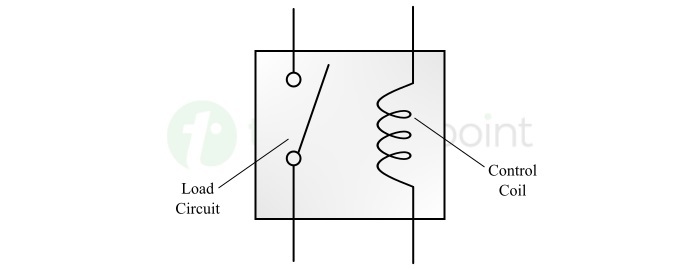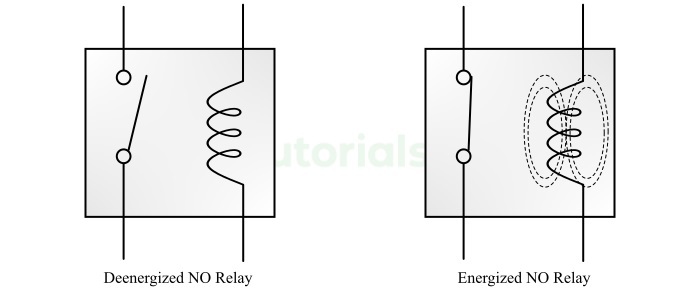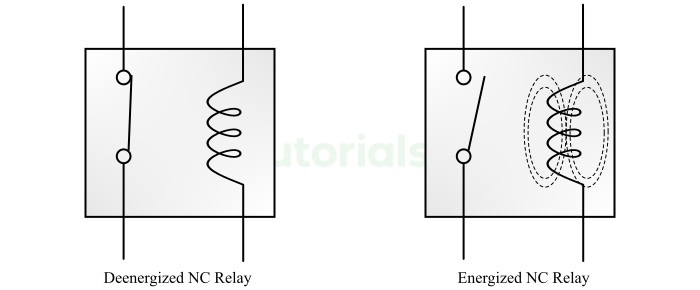
 Data Structure
Data Structure Networking
Networking RDBMS
RDBMS Operating System
Operating System Java
Java MS Excel
MS Excel iOS
iOS HTML
HTML CSS
CSS Android
Android Python
Python C Programming
C Programming C++
C++ C#
C# MongoDB
MongoDB MySQL
MySQL Javascript
Javascript PHP
PHP
- Selected Reading
- UPSC IAS Exams Notes
- Developer's Best Practices
- Questions and Answers
- Effective Resume Writing
- HR Interview Questions
- Computer Glossary
- Who is Who
How Does an Electrical Relay Work?
In electrical engineering, a relay is an electromagnetic or an electronic switch that can automatically operate if any abnormal conditions occur in the circuit.
The primary functions of a relay are to monitor the circuit, sense the fault, and initiate the tripping of the circuit if a fault occurs in the system.
Read this article to learn the operation of a relay. Let's start with some frequently used terms related to the operation of a relay.
Relay Operation Terminology
The following are some key terms related to the operation of a relay in power system.
Operating Force or Torque - A force or torque that tends to close the contacts of the relay is called the operating force or torque.
Restraining Force or Torque - A force or torque that opposes the operating force or torque is called the restraining force or torque. If the value of the restraining force is greater than the operating torque, the relay will not operate and vice-versa.
Pickup Value - The value of the actuating quantity like current or voltage above which the relay will operate is called the pickup value.
Reset Value - The threshold value of the actuating quantity like current or voltage below which the relay is deenergized and comes back into its normal operating condition is known as reset value.
These are some basic terms which are important to understand the operation of a relay. Let us now get the basic details about main components of a relay.
Main Components of Relay
A typical relay consists of the following main components -
Electromagnetic Coil - It is a winding of copper wire used to generate the operating magnetic field.
Armature - It is a movable component of a relay and is made up of ferromagnetic material. It can move in response to the magnetic field.
NO Contacts - NO contacts stand for Normally Open contacts. These contacts remain open when relay is not energized.
NC Contacts - NC contacts stand for Normally Closed contacts. These contacts remain closed when the relay is not energized and become open when the relay operates.
Principle of Relay Operation
The operation of a relay is based on the value of operating force or torque and restraining force or torque. In other words, the operation of relay depends on whether the operating force is smaller or greater than the restraining force.
The equation of the relay operation is given below,
$$\mathrm{F\:=\:F_O\: \:F_r}$$
Or,
$$\mathrm{T\:=\:T_O\: \:T_r}$$
Where,
- F and T are the net force and torque respectively,
- $\mathrm{F_O\:and\:T_O}$ are the operating force and torque respectively, and
- $\mathrm{F_r\:and\:T_r}$ are the restraining force and torque respectively.
In these equations, if the $\mathrm{F_O\:\gt \:F_r\:or\:T_O\:\gt \:T_r,}$ then the net force F or net torque T are positive, and hence the relay will operate.
In electromagnetic or electromechanical relays, the operating torque is produced by the magnetic field and the restraining torque is produced by a spring.
Let us now understand the operation of a relay in different operating states.
Operation of a Relay
To understand the operation of a relay, let us consider a 4-pin relay. A typical relay consists of two circuits namely, a control circuit and a load circuit, as shown in the following figure.

The control circuit controls the operation of the relay or we can say the flow of current in the load circuit. Let us now discuss the different operating states of the relay.
Energized Relay
It is also known as ON state of the relay. The relay is said to be energized when a current flows through its control coil and creates a magnetic field that causes the switch to close in the load circuit. This relay operation is shown in the following figure.

Deenergized Relay
It is referred to as OFF state of the relay. The relay is said to be de-energized when the current stops flowing through the control coil and no magnetic field exists there. In this operating state, the load switch opens and the flow current in load circuit becomes zero.
The deenergized state of a relay is shown in the following figure.

Operation of Normally Open Relay
A normally open relay is one that has its load circuit switch open until its control coil is energized. It is also known as NO relay. The deenergized and energized states of the normally open relay are shown in the following figure.

Operation of Normally Closed Relay
A normally closed relay is a type of relay in which load circuit switch remains closed until its control coil is energized. The deenergized and energized states of the normally closed relay are shown in the figure below.

Conclusion
In conclusion, a relay can have two operational states named, energized and deenergized. When there is a current flowing through its control coil, then it is said to be energized and when there is no current flow through the control coil, then the relay is said to be deenergized.
In this article, we explained everything about the operation of a relay that you require for working with relays and protection systems.
FAQs Related to Operation of Relay
The following section is meant for answering some commonly asked questions related to the operation of a relay.
1. How does a relay work step by step?
The step-by-step working of a relay is explained below -
Step 1 - Firstly, the control coil of the relay is energized and it generates a magnetic field.
Step 2 - The magnetic field generated by the control coil attracts the armature.
Step 3 - The movable contact is attached to the armature and hence it also moves when the armature do.
Step 4 - Due to armature movement, the load switch of the relay operates, either open or close, to control the load circuit supply.
2. Where does relay operate?
A relay is to be operated where we need to control the high amount of power using a low amount of power in an electric circuit. Also, it is used to implement automatic operation of the electrical system.
3. What are the advantages of relay?
The following are some key benefits of relay -
- A relay can control high amount of power using a small power electric signal.
- It can operate automatically when a signal is received.
- A relay can be used in both AC and DC circuits.
- A relay can perform switching at a very fast speed.
4. Which relay is mostly used?
Electromagnetic type relay is the most widely used type of relay in electrical and electronics engineering.

